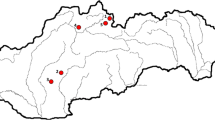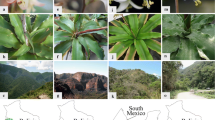Abstract
Hybridization and genetic swamping by planted exotic Populus taxa are putative threats for native Populus resources. We investigated the potential for hybridization between the exotic hybrid Populus x canadensis Moench and its wild relative, the European black poplar (Populus nigra L.), by a series of pollination experiments in the greenhouse. We also tested the effect of mixtures of pollen from the taxon’s own pollen and pollen of the foreign taxon on mating success in reciprocal crosses. We observed reduced pollen and seed viability of the hybrid clones of P. x canadensis compared to the clones of the parental species P. nigra. Surprisingly, when in combination with pollen of its wild relative P. nigra, pollen of exotic P. x canadensis sired significantly better on its own flowers. In poplar breeding, the pollen mentor technique which uses pollen mixes of artificially inactivated conspecific pollen and untreated incompatible foreign pollen, has been successfully used to overcome incompatibility barriers. The results of this study suggest that in the wild, where mixed pollen loads are common, similar effects as the pollen mentor effects may enhance the invasiveness of exotic P. x canadensis. This study helps to explain former field observations and contributes to the understanding of potential environmental impacts of commercial exotic and transgene poplar plantations.




Similar content being viewed by others
References
Arens P, Coops H, Jansen J, Vosman B (1998) Molecular genetic analysis of Black poplar (Populus nigra L.) along Dutch rivers. Mol Ecol 7:11–18
Arnold ML (1997) Natural hybridization and evolution. Oxford University Press, Oxford
Benetka V, Vacková K, Bartáková I, Popísková M, Rasl M (2002) Introgression in black poplar (Populus nigra L. ssp. P. nigra) and its transmission. Forest Science 48:115–120
Cervera M-T, Storme V, Ivens B, Gusmao J, Liu Ben H, Hostyn V, Van Slycken J, Van Montagu M, Boerjan W (2001) Dense genetic linkage maps of three Populus species (Populus deltoides, P. nigra and P. trichocarpa) based on AFLP and microsatellite markers. Genetics 1(58):787–809
Chenault N, Arnaud-Haond S., Juteau M, Valade R, Almeida JL, Villar M, Bastien C, Dowkiw A. (2011) SSR-based analysis of clonality, spatial genetic structure, and introgression from the Lombardy poplar into a natural population of Populus nigra L. along the Loire River. Tree Genet Genomes 7(6):1–14
Conover WJ (1980) Practical nonparametric statistics, 2nd edn. New York
Desrochers AM, Riesenberg LH (1998) Mentor effects in wild species of Helianthus (Asteraceae). Am J Bot 85:770–775
DiFazio SP, Leonardi S, Slavov GT, Garman SL, Adams WT, Strauss SH (2012) Gene flow and simulation of transgene dispersal from hybrid poplar plantations. New Phytologist 193:903–915
Ellstrand NC, Prentice HC, Hancock JF (1999) Gene flow and introgression from domesticated plants into their wild relatives. Annu Rev Ecol Syst 30:539–563
Fleiss JJ (1981) Statistical methods for rates and proportions, 2nd edn. Wiley, New York
Gaget M, Villar M, Dumas C (1989) The mentor pollen phenomenon in poplars: a new concept. Theor Appl Genet 78:129–135
Gaudet M, Jorge V, Paolucci I, Beritognolo I, Mugnozza GS, Sabatti M (2008) Genetic linkage maps of Populus nigra L. including AFLPs, SSRs, SNPs, and sex trait. Tree Genet Genomes 4:25–36
Heinze B (2008) Genetic traces of cultivated hybrid poplars in the offspring of native Populus nigra in Austria. Preslia 80:365–374
Imbert E, Lefèvre F (2003) Dispersal and gene flow of Populus nigra (Salicaceae) along a dynamic river system. J Ecol 91:447–456
Knox RB, Willing RR, Pryor LD (1972) Interspecific hybridization in poplars using recognition pollen. Silvae Genetica 21:65–69
Label P, Imbault N, Villar M (1994) ELISA quantitation and GC-MS identification of abscisic acid in stigma, ovary and pedicel of pollinated poplar flowers (Populus nigra L.). Tree Physiol 14:521–530
Laikre L, Schwartz MK, Waples RS, Ryman N, GeM WG (2010) Compromising genetic diversity in the wild: unmonitored large-scale release of plants and animals. Trends Ecol Evol 25:520–529
Lefèvre F, Légionnet A, de Vries SMG, Turok J (1998) Strategies for the conservation of a pioneer tree species, Populus nigra L., in Europe. Genet Sel Evol 30:181–196
Lefèvre F, Kajba D, Heinze B, Rotach P, de Vries SMG, Turok J (2001) Black poplar: a model for gene resource conservation in forest ecosystems. For Chron 77:239–244
Levin DA, Fancisco-Ortega JK, Jansen RK (1996) Hybridization and the extinction of rare plant species. Conserv Biol 10:10–16
Marshall TC, Slate J, Kruuk LEB, Pemberton JM (1998) Statistical confidence for likelihood-based paternity inference in natural populations. Mol Ecol 7:639–655
Matsumoto T, Takakura KI, Nishida T (2010) Alien pollen grains interfere with the reproductive success of native congener. Biol Invasions 12:1617–1626
Meirmans PG, Lamothe M, Gros-Louis MC, Khasa D, Perinet P, Bousquet J, Isabel N (2010) Complex patterns of hybridization between exotic and native North American poplar species. Am J Bot 97:1688–1697
Ottaviano E, Mulcahy DL (1989) Genetics of angiosperm pollen. Adv Genet 26:1–64
Pandey KK (1978) Proposed causal mechanisms of the “mentor pollen effect”. Incompatibility Newsletter 10:87–93
Rajora OP, Zsuffa L (1986) Pollen viability of some Populus species as indicated by in vitro pollen germination and tetrazolium chloride staining. Can J Bot 64:1086–1088
Richardson DM (1998) Forestry trees as invasive aliens. Cons Biol 12:18–26
Slavov GT, Leonardi J, Burczyk WT, Adams T, Strauss H, Difazio SP (2009) Extensive pollen flow in two ecologically contrasting populations of Populus trichocarpa. Mol Ecol 18:357–373
Smulders MJM, van der Schoot J, Arens P, Vosman B (2001) Trinucleotide repeat microsatellite markers for Black poplar (Populus nigra L.). Mol Ecol Notes 1:188–190
Smulders MJM, Cottrell JE, Lefevre F, van der Schoot J, Arens P, Vosmam B, Tabbener HE, Grassi F, Fossati T, Castiglione S, Krystufek V, Fluch S, Burg K, Vornam B, Pohl A, Gebhardt K, Alba N, Agundez D, Maestro C, Notivol E, Volosyanchuk R, Pospiskova M, Bordacs S, Bovenschen J, van Dam BC, Koelewijn HP, Halfmaerten D, Ivens B, Van Slycken J, Vanden-Broeck A, Storme V, Boerjan W (2008) Structure of the genetic diversity in black poplar (Populus nigra L.) populations across European river systems: consequences for conservation and restoration. For Ecol Manage 255:1388–1399
Stanton BJ, Villar M (1996) Controlled reproduction of Populus. In: Stettler RF, Bradshaw Jr HD, Heilman PE, Hinckley TM (eds), Biology of Populus. NNRC Research Press, National Research Council of Canada, Ottawa, Canada, pp 113–138
Stettler RF (1968) Irradiated mentor pollen: its use in remote hybridization of black cottonwood. Nature 219:746–747
Stettler RF, Zsuffa L, Wu R (1996) The role of hybridization in the genetic manipulation of Populus. In: Stettler HD, Bradshaw Jr HE, Heilman PE, Hinckley TM (eds), Biology of Populus. NRC Research Press. National Research Council of Canada, Ottawa, Canada, pp 87–112
Storme V, Vanden Broeck A, Ivens B, Halfmaerten D, Van Slycken J, Castiglione S, Grassi F, Fossati T, Cottrell JE, TabbenerHE LefèvreF, Saintagne C, Fluch S, Krystufek V, Burg K, Bordács S, Gebhardt K, Vornam B, Pohl A, Alba N, Agúndez D, Bovenschen J, van Dam BC, van der Schoot J, Vosman B, Boerjan W, Smulders MJM (2004) Ex-situ conservation of Black poplar in Europe: genetic diversity in nine gene bank collections and their value for nature development. Theor Appl Genet 108:969–981
Strauss SH, Difazio SP, Meilan R (2001) Genetically modified poplars in context. For Chron 77:271–279
Strauss SH, Tan HM, Boerjan W, Sedjo R (2009) Strangled at birth? Forest biotech and the convention on biological diversity. Nat Biotechnol 27:519–527
Tabbener HE, Cottrell JE (2003) The use of microsatellite markers to study paternity in seedlings produced by a range of poplar species. For Ecol Manage 179:363–376
Thompson SL, Lamothe M, Meirmans PG, Perinet P, Isabel N (2010) Repeated unidirectional introgression towards Populus balsamifera in contact zones of exotic and native poplars. Mol Ecol 19:132–145
van der Schoot J, Pospísková M, Vosman B (2000) Development and characterization of microsatellite markers in black poplar (Populus nigra L.). Theor Appl Genet 101:317–322
Vanden Broeck A, Cox K, Quataert P, Van Bockstaele E, Van Slycken J (2003a) Flowering phenology of Populus nigra L., P. nigra cv. italica and P. x canadensis Moench. and the potential for natural hybridisation in Belgium. Silvae Genetica 52:280–283
Vanden Broeck AH, Quataert P, Rodán-Ruiz I, Van Bockstaele E, Van Slycken J (2003b) Pollen competition in P. nigra females revealed by microsatellite markers. For Genet 10:219–227
Vanden Broeck A, Storme V, Cottrell JE, Boerjan W, Van Bockstaele E, Quataert P, Van Slycken J (2004) Gene flow between cultivated poplars and native black poplar (Populus nigra L.): a case study along the river Meuse on the Dutch-Belgian border. For Ecol Manage 197:307–310
Vanden Broeck A, Villar M, Van Bockstaele E, Van Slycken J (2005) Natural hybridization between cultivated poplars and their wild relatives: evidence and consequences for native poplar populations. Ann For Sci 62:601–613
Villar M, Gaget-Faurobert A (1997) Mentor effects in pistil-mediated pollen–pollen interactions. In: Sawhney K, Shivana KR (eds) Pollen Biotechnology for crop production and improvement. Cambridge University Press, Cambridge, pp 315–332
Visser T, Verhaegh JJ, Marcucci MC, Uijtewaal BA (1983) Pollen and pollination experiments. The effect of successive pollinations with compatible and self-incompatible pollen in apple and pear. Euphytica 32:57–64
Wang JH, Constabel CP (2004) Polyphenol oxidase overexpression in transgenic Populus enhances resistance to herbivory by forest tent caterpillar (Malacosoma disstria). Planta 220:87–96
Wheeler N, Payne P, Hipkins SR, Kenny S, Tuskan G (2006) Polymix breeding with paternity analysis in Populus: a test for differential reproductive success (DRS) among pollen donors. Tree Genet & Genomes 2:53–60
Wilcoxon F (1945) Individual comparisons by ranking methods. Biometrics 1:80–83
Wolf DE, Takebayashi N, Rieseberg LH (2001) Predicting the risk of extinction through hybridization. Cons Biol 15:1039–1053
Yamashita K, Oda K, Nakamura N (1990) Seed development in self-pollination of 4X Hyuganatsu and reciprocal crosses between 2X and 4X Hyuganatsu, and overcoming the self-incompatibility of 2X Hyuganatus using pollen of 4X Hyuganatsu. J Jpn Soc Hortic Sci 59:23–28
Ziegenhagen B, Gneuss S, Rathmacher G, Leyer I, Bialozyt R, Heinze B, Liepelt S (2008) A fast and simple genetic survey reveals the spread of poplar hybrids at a natural Elbe river site. Conserv Genet 9:373–379
Acknowledgments
We thank Wim Declercq, André Meersman, Serge Goossens and particularly Paul Remy who retired in 2009, for performing the controlled crosses and for the excellent assistance in the greenhouse. We also thank An Van Breusegem, Leen Verschaeve, David Halfmaerten, Nancy Van Liefferinge and Sabrina Neyrinck for the excellent laboratory assistance.
Author information
Authors and Affiliations
Corresponding author
Electronic supplementary material
Below is the link to the electronic supplementary material.
Rights and permissions
About this article
Cite this article
Vanden-Broeck, A., Cox, K., Michiels, B. et al. With a little help from my friends: hybrid fertility of exotic Populus x canadensis enhanced by related native Populus nigra . Biol Invasions 14, 1683–1696 (2012). https://doi.org/10.1007/s10530-012-0180-6
Received:
Accepted:
Published:
Issue Date:
DOI: https://doi.org/10.1007/s10530-012-0180-6




